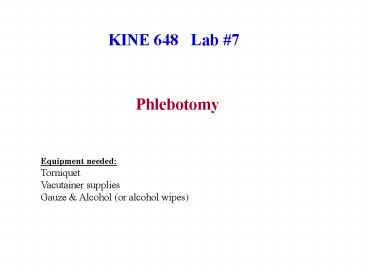Phlebotomy PowerPoint PPT Presentation
1 / 9
Title: Phlebotomy
1
KINE 648 Lab 7
Phlebotomy
Equipment needed Torniquet Vacutainer
supplies Gauze Alcohol (or alcohol wipes)
2
Selecting a Puncture Site
- Palpate and trace the path of veins with the
index finger. Arteries pulsate, are most
elastic, and have a thick wall. Thrombosed veins
lack resilience, feel cord-like, and roll
easily. - If superficial veins are not readily apparent,
you can force blood into the vein by massaging
the arm from wrist to elbow, tap the site with
index and second finger, apply a warm, damp
washcloth to the site for 5 minutes, or lower
the extremity over the chair or bedside to allow
the veins to fill.
Areas to Avoid When Selecting a Puncture Site
- Extensive scars from burns and surgery
- The upper extremity on the side of a previous
mastectomy - test results may be affected
because of lymphedema. - Hematoma - may cause erroneous test results. If
another site is not available, collect the
specimen distal to the hematoma. - Edematous extremities - tissue fluid
accumulation alters test results.
3
Performing a Venipuncture using the Vacutainer
System
- Position the patient so as to hyperextend the
arm. - Apply the tourniquet 3-4 inches above the
selected puncture site. Do not leave on more
than 2 minutes. - The patient should make a fist without pumping
the hand. - Prepare the patient's arm using an alcohol
prep. - Grasp the patient's arm firmly using your thumb
to draw the skin taut and anchor the vein. The
needle should form a 15 to 30 degree angle with
the surface of the arm. Swiftly insert the
needle through the skin and into the vein lumen. - Insert the vacutainer so as not to move the
needle placement at all. - Fill all necessary vacutainer tubes, taking
care not to disturb the puncture site. - Remove the needle from the patient's arm using
a swift backward motion. - Simultaneously press down on the puncture site
with a piece of gauze once the needle is out of
the arm. - Bandage the patient appropriately and label the
specimen - Dispose of contaminated materials/supplies in
designated containers.
4
Correct Needle Placement
Useful web site containing venipuncture
tutorial http//library.med.utah.edu/WebPath/TUT
ORIAL/PHLEB/PHLEB.html Useful web sites for
starting IVs www.mrprotocols.com/sset/iv.html
nursingcrib.com/starting-an-intravenous-infusion
/
5
Palpating the Vein
6
Inserting the Needle
7
Common Blood Tests for Heart Disease Risk
Test Uses
Normal Ranges
Glucose Test for diabetes 75 - 110 mg/dL
Cholesterol Used to test for cardiac risk 120 - 200 mg/dL
Triglycerides Circulating blood fat - cardiac risk 10 - 160 mg/dL
HDL Cholesterol The Good cholesterol 29 - 67 mg/dL
LDL Cholesterol The Bad cholesterol lt 130 mg/dL
Creatine Kinase (CPK) Indicator of myocardial infarction Men 38 - 74 U/L Women 26 - 140 U/L
Brain Natriuretic Peptide (BNP) Test for heart failure lt 17.9 pg/ml
8
Tests for Renal and Hepatic Function
Test Indicatios
Uses Normal Ranges
Sodium Body fluid balance (kidneys - heart) 137 - 145 mmol/L
Potassium Check acid - base, water balance 3.6 - 5.0 mmol/L
Choloride Check acid - base, water balance 98 - 107 mmol/L
Urea Nitrogen (BUN) u r impaired kidney filtration 9 - 21 mg/dL
Creatinine d r impaired kidney clearance 0.8 - 1.5 mg/dL
Bilirubin (Hg metabolite) u r impaired liver function 0.2 - 1.3 mg/dL
Total Protein u r dehydration, renal failure d r malnutrition 6.3 - 8.2 g/dL
Albumin d r malnutrition, liver problems 3.5 - 5.0 g/dL
Globulin u r infections, collagen diseases 2.4 - 3.5 g/dL
Alb/Glob Ratio d r inflammation and infection 1.2 - 2.2
9
Tests for Renal Function, Hepatic Function, and
Cancer
Test Uses
Indications Normal Ranges
Uric Acid u r Gout, renal failure, leukemia 2.5 - 8.5 mg/dL
Alkaline Phosphatase u r Liver bone disease (cancer) 38 - 126 U/L
AST u r cell death in highly metabolic tissue (MI, hepatitis, cirrhosis, cancer) 17 - 59 U/L
LDH u r heart, liver, or lung damage 313 - 618 U/L
ALT u r Liver disease (cirrhosis, cancer) 7 - 56 U/L
Gamma GT (GGT) u r Liver damage, obstruction, alcoholism 15 - 73 U/L
Prostate Specific Antigen (PSA) u r prostate hypertrophy or prostate cancer 0 - 4.0 ng/mL
CA 125 u r ovarian and breast cancer 0 - 35 U/ml

